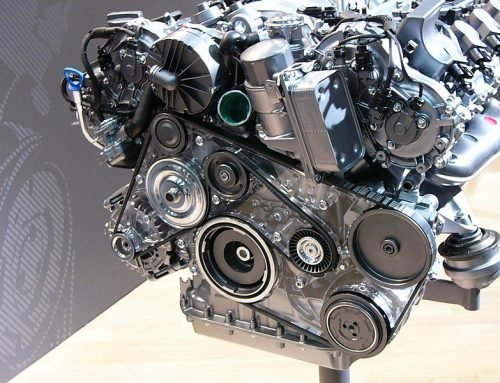Motor oil is an essential part of keeping any vehicle running, be it a Mercedes-Benz or otherwise. Look after your oil, and it will look after your Mercedes.
In addition to luxury, Mercedes-Benz vehicles are designed for performance and maximum efficiency. As such, oil cooling is extremely important due to the amount of heat generated by these powerful engines.
Just like any other mechanical component however, your engine’s oil cooler can fail, causing a host of problems and degrading your engine’s performance and reliability.
Today, our Mercedes-Benz mechanics in Melbourne explain the role of your engine cooler, as well as well as how you can identify signs of an oil cooler leak.
The purpose of oil coolers
As any Mercedes-lover knows, maintaining the right oil temperature is crucial to ensuring your car continues to perform.
Temperature affects the viscosity of your motor oil, which in turn affects its ability to lubricate your engine. Too high a temperature, and your motor oil thins out and can even start to degrade.
To solve that issue, many Mercedes-Benz vehicles come with oil coolers as standard.
Before the oil enters the sump or oil reservoir to be distributed around your engine, it needs to be regulated to account for the high operating temperature of the engine, and to ensure that the oil remains at an optimal viscosity.
By passing the oil through an oil cooler (also known as a heat exchanger) your engine oil is able to reach the ideal operating temperature faster, and regulate the engine temperature along with the engines coolant.
This is how the engine is able to maintain its ideal temperature (and therefore, the ideal viscosity) needed to properly lubricate your engine, keep emissions as low as possible and maintain engine performance.
Our Mercedes-Benz mechanics in Melbourne explain how your oil cooler works
Wedged between the engine block and oil filter, oil coolers can be found in much of the Mercedes-Benz catalogue.
Most Mercedes use what we call a stack plate heat exchanger.
This system uses alternating pathways to cool your oil. Cold coolant is pumped through one end, and run through narrow pathways.
Alternating with these coolant pathways are pathways for motor oil.
When motor oil is pumped through the oil cooler, it is sandwiched by smaller pathways that contain coolant from your engine’s cooling system.
As oil runs through the cooler, heat is transferred (exchanged) from the hot motor oil to the adjacent pathways containing coolant, regulating the temperature of your engine oil.
Once it’s regulated, your motor oil flows back out and goes through the rest of the engine, while coolant returns to your engine’s cooling system.
What prevents the oil becoming too cold? An engine’s temperature is maintained by the cooling system (radiator, water pump and fan), which uses a thermostat to keep the coolant inside the engine at the ideal temperature.
Therefore as the engine coolant is controlled, so too is the engine oil. This is how an engine can maintain the right temperature regardless of the ambient temperature outside.
Are there any models I should look out for?
The Mercedes-Benz OM642 is a 3.0L V6 diesel engine, which is offered in some of Mercedes’ most popular models. It combines the power and durability Mercedes is known for with the efficiency and energy-density of diesel fuel.
However, early OM642 engines come with a flaw in the way that the oil cooler seals were designed.
Specifically, the original oil cooler seals were prone to premature degradation from the significant amount of heat they are exposed to.
The result? Oil or coolant leaking from your oil cooler.
All models that were equipped with a pre-2010 OM642 may be affected by this problem. Some affected models include:
- Mercedes-Benz Sprinter
- Mercedes-Benz Vito / Viano
- Mercedes-Benz C Class, C320/350
- Mercedes-Benz R Class, R320/350 CDI
- Mercedes-Benz E Class, E320/350
- Mercedes-Benz M Class, ML320/350 CDI
- Mercedes-Benz GL Class, GL320/350 CDI
Starting in 2010, Mercedes introduced seals made of more durable Viton synthetic rubber, remedying this issue. You can find out what seals your Mercedes uses by taking a look yourself – new Viton seals can be identified by their factory purple colour
Other issues with oil coolers
While the issues with failing cooler seals is a common one, it isn’t the only defect that can cause a leak or other problems.
The oil that flows through the cooler is under very high pressure. If the cooler starts to block up from degraded oil, it can raise the pressure in the system even higher, causing seals to leak. It is for this reason we replace the cooler altogether along with the seals on engines with higher mileage.
In some other European cars (like the BMW X3 and X5), the heat exchangers often fail in a different way. An over pressurised cooling system ruptures the heat exchanger internally, causing coolant and oil to mix together. This can happen to both the engine or transmission cooler, and can cause significant consequential damage.
If you have an oil cooler leak, you will most likely know about it from some obvious signs, such as the oil needing to be topped up regularly, or the mess on your garage floor where you park.
Repairing an oil cooler leak
In the event that the issue lies with the seals, your Mercedes-Benz mechanic in Melbourne replace the affected seals with the upgraded Viton seals. We’ll also clean up any dried oil and residue while we’re there.
Repairing an oil cooler leak is often a big job. In the case of the Mercedes-Benz OM642 engine, the cooler is located in the valley of the engine, and require considerable work to reach.
First, you’ll have to remove the:
- Air intake ducts
- Fuel filter and lines
- Turbocharger
- Intake port shut off motor
- EGR cooler and valve
- Intake manifolds
- Coolant lines
That’s a lot of work – even with our experience, the repair can take several days to complete. And that’s with access to all the specialised equipment and tooling in our Mercedes-Benz specialist workshop.
We strongly recommend leaving this job to a professional! There are several parts to this repair that require finesse and delicate handling.
On an aging engine, some of the components (namely the intake flap levers) attached to the intake manifold are made of plastic and become brittle over time. In some cases they are broken or break on removal. Replacing the intake manifolds adds considerable cost to this repair!
It’s important to contact a professional Mercedes-Benz mechanic the moment you notice the signs of an oil cooler leak.
When oil cooler leaks are taken to a non-specialist mechanic who is unfamiliar with this repair, there is a high probability of the repair not being done correctly on the first attempt. This can be costly, not only in the time of the repair, but additional components that will need to be replaced if broken!
An experienced Mercedes-Benz mechanic in Melbourne, on the other hand, will be able to diagnose and perform the repair on the first attempt, replacing only what is required.
Need a Mercedes-Benz mechanic in Melbourne?
Ammstar fixes oil cooler leaks and more
As a specialist in luxury European cars, Ammstar has considerable experience working with Mercedes-Benz. Whether it’s a luxury S Class or commercial use Vito van, you can trust us to get to the root of the problem.
Unlike the corner mechanic, we work exclusively with luxury European brands such as Mercedes-Benz. We’ll diagnose the problem, and provide the right fix the first time.
And unlike the dealership, we can do this while simultaneously offering some of the most competitive prices for Mercedes-Benz service in Melbourne!
If you’re looking for a better service, there’s no competition – make a booking online to find out how we can provide a superior service.



